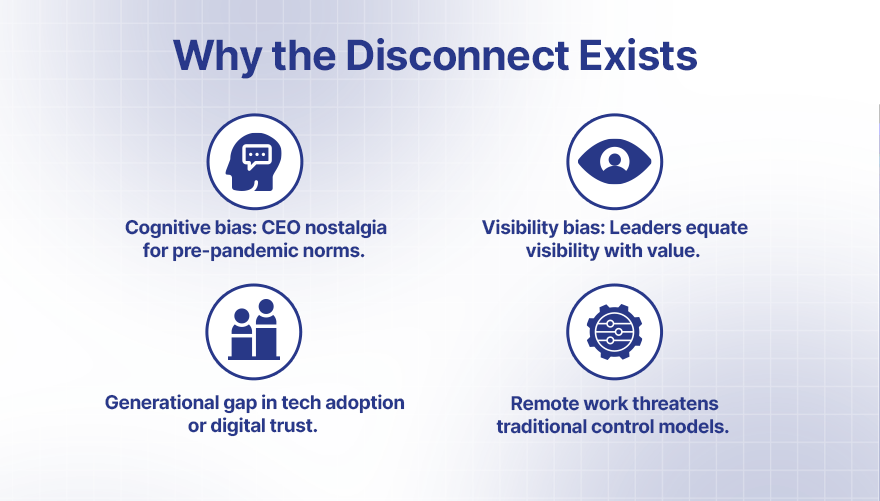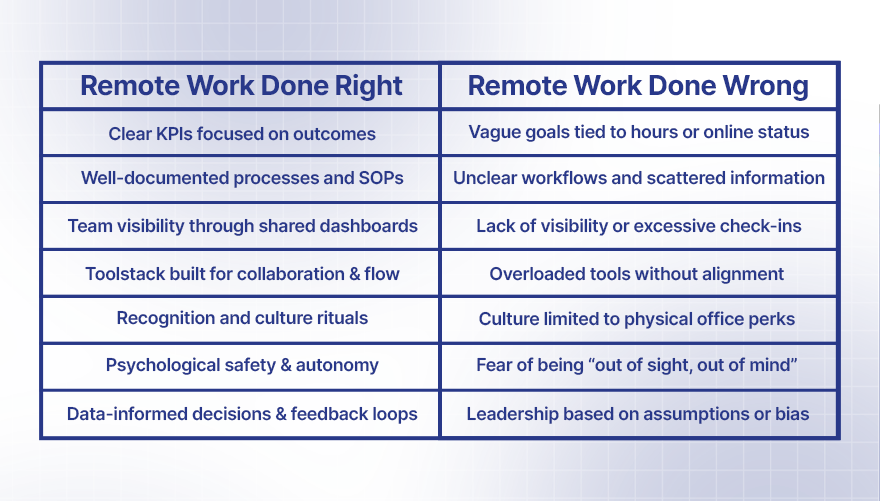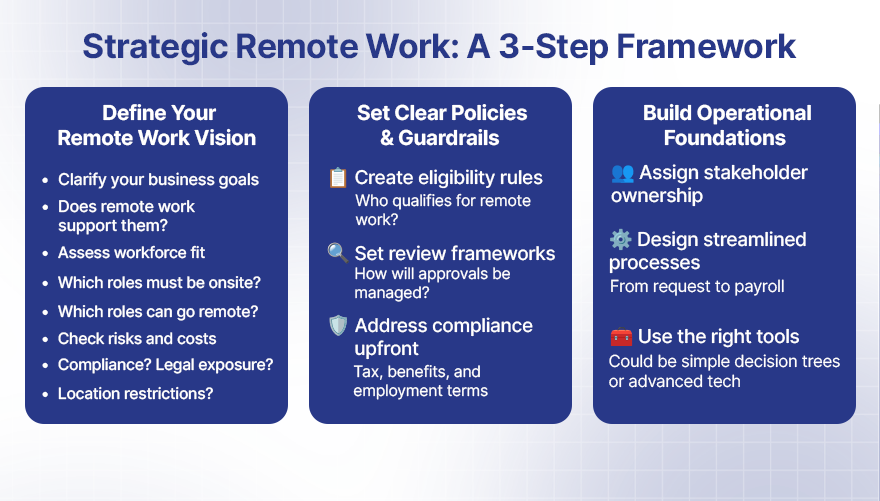Table of Contents
In 2020, when the COVID outbreak spread, businesses had no option other than allowing their teams to work remotely. That’s where the rise of remote work culture began, which has gained popularity over the years. However, now 78% of business owners think that remote work can derail productivity.
But when this statement comes from popular figures, analyzing the remote work trend and reviewing remote work statistics becomes more important than ever. For instance, big giants like ‘META’ and ‘Goldman Sachs’ have made it mandatory for their employees to work on-site.
According to a report by Business Insider, Apple CEO Tim Cook expressed concerns about remote work, stating that it was “not like being together physically,” and that the lack of spontaneous corridor interactions could limit creativity.
On the other hand, Forbes stated that 98% of working professionals want to work remotely. When almost the global workforce prefers a remote setup, it’s important that we make decisions based on real data and remote work statistics instead of intuition or gut feeling.
As companies push for return-to-office mandates in 2025, many leaders are making decisions based on gut feeling, anecdotal feedback, or old-school beliefs. But when you stack those beliefs against actual data, the disconnect becomes impossible to ignore.
This blog doesn’t aim to take sides—it’s here to challenge assumptions. We’ll unpack the biggest myths around remote work productivity and lay out what the numbers (and forward-thinking companies) are actually telling us.
Myth #1: People got lazy while working from home

What CEOs Say:
As reported in a conference in California, The CEO of Frontier Airlines, Barry Biffle, said, “We got lazy in COVID. I mean seriously, people are still allowing people to work from home, all this silliness, right? All that’s out the window. So, we need to get people back in the office.”
Biffle stated that people are “not so productive” as they used to be in 2019.
What data says:
Data across the world counters the notion that remote work is equivalent to unproductivity.
- The Standford study, based on 16,000 professionals, revealed that remote workers discovered that their productivity levels have increased by 13%.
- 55% of working professionals tend to invest more hours daily in remote work as compared to working in an office.
- The Gartner study stated that 43% of the workforce feels more productive when they have the flexibility to work other than being restricted to on-site setups.
Key takeaway: Don’t confuse visibility with productivity. If you’re still equating performance with hours or online status, you’re not measuring work—you’re measuring presence. Shift your leadership mindset from attendance tracking to value creation.
Myth #2: Remote workers can’t lead well

What CEOs Say:
Another divisive claim about remote work comes from the CEO of JPMorgan Chase, Jamie Dimon. He said to the Economist, “I do not believe you can be a leader and not be accessible to your people. I completely understand why someone doesn’t want to commute an hour and a half every day, totally get it. Doesn’t mean they have to have a job here either.”
Even when employees resisted and complained about the strict return-to-office (RTO) policy, it didn’t change the perspective of Dimon.
What data says:
- Gallup stated that among global working professionals, 54% said they would prefer jobs that give them flexibility to work anywhere other than those that restrict it.
- With the right technologies, it is easier to keep your teams transparent, accountable, and more accessible from anywhere. Tools like employee monitoring software enabled higher productivity levels in operations for almost 85% of the companies.
- Remote workers are 13% less likely to leave their jobs as compared to those who don’t have the flexibility to work from home. This data ensures the idea that managers can not only lead their teams well but can make them more stable and committed with the right support and leadership.
Key takeaway: The next generation of leaders will be those who master influence without proximity. Remote leadership is the ultimate test of clarity, empathy, and system design. Start grooming managers for digital leadership—not just in-office supervision.
Myth #3: Remote workers hinder success

What CEOs Say:
The CEO of Salesforce, Marc Benioff, who once supported remote work initially, has now changed his perspective, saying, “For our new employees who are coming in, we know empirically that they do better if they’re in the office, meeting people, being onboarded, being trained. And if they are at home and not going through that process, we don’t think they’re as successful.” He mentioned this on the Podcast: “On With Kara Swisher”
What data says:
- When talking about communication and collaboration, data shows that only 8% of remote workers face challenges. It means with the right tools and technologies; social engagement and networking are not a hurdle in remote setups.
- 78% companies have implemented communication and collaboration tools in their remote operations and 71% using it daily for 1 on 1 daily meetings—helping them in seamless connectivity, onboarding and training of employees.
- The value of both structured and informal interactions is highlighted by the fact that 40% of professionals believe that daily standups are the best way to stay connected remotely, while 22% prefer informal check-ins and 20% place a premium on periodic feedback.
Key takeaway: Remote work doesn’t slow growth—poor remote infrastructure does. Invest in onboarding, digital-first collaboration, and cultural integration early. Remote success isn’t plug-and-play—it’s architected intentionally.
Myth #4: Remote workers aren’t creative or Innovative
What CEOs Say:
3-D printing technology’s CEO, Ellen Kullman, mentioned in the Wall Street Journal that only people who work in person can be creative.
He also expressed concern about innovation, saying, “What I worry about the most is innovation. Innovation is hard to schedule, it’s impossible to schedule”
- Deloitte reported that 54% of employers agree that remote work has enabled a diverse and inclusive workforce, helping them reach out bigger talent pool—ultimately leading to increased innovation and creativity.
- The sense of happiness and satisfaction at work keeps employees creative, energized, and motivated. A survey of 12,455 working professionals revealed that fully remote work can boost happiness at work by 20%, reinforcing the fact that innovation and happiness begin from job happiness and satisfaction.
Key takeaway: Innovation doesn’t suffer in remote—it suffers in rigid, one-size-fits-all systems. True creativity flourishes where autonomy meets accountability. Reimagine brainstorming, co-creation, and problem-solving in async-first, globally-inclusive formats.
Why the Disconnect Exists: Why Leaders Still Don’t Trust Remote Work

The reason that many cohorts of chiefs are raising their disdain for remote work is not even data—it is more about deep-rooted leadership psychology. Here are some factors that drive CEOs to push RTO policies:
Fear of Change and Loss of Control:
The majority of the world’s CEO population falls under the age group of 50-60 years. It means they have thrived in a professional environment where structure, predictability, and oversight have been cherished. Therefore, remote work models don’t fit their perspective and experience. Moreover, it can also disrupt their confidence and clarity in leading a team. The fear is not only about remote work productivity, but also about losing control and operating in a way they have never thought of.
Cognitive Biases:
Leaders operate with three most common biases when it comes to adopting remote work setups:
- Confirmation bias- Only believe the information and facts that justify what they already believe about remote work.
- Status quo bias- Preferring current ways of operating rather than adopting modern work setups (even if it has the possibility to deliver positive outcomes)
- Control bias- Believing that productivity and quality can only be maintained with physical supervision and collaboration.
Distrust in Employee Motivation & Morale:
Over 40% of leaders trust that remote work can significantly reduce motivation to work with their employees. It means that they believe in the fact that motivation is a quality that is driven externally rather than being intrinsic.
Cultural and Social Concerns:
Many leaders believe that company culture that relies on collaboration, team spirit, and transparency could get faded after shifting to a remote workforce. The absence of informal conversations among employees and water cooler chats can reduce creativity, communication, and engagement.

Download Free Remote-Ready Culture Checklist
Beyond Myths: The Right Way to Approach Remote Work
Myths about remote work only arise when it doesn’t deliver the desired results. It is important to understand that like other work models, the remote setup is also just a model—neither a magic bullet nor a villain. Only if it is implemented the right way, using proven remote work productivity tips and strategies for remote work productivity, will you get its benefits like increased ROI, reduced operational costs, better remote work productivity, employee well-being, and more.

What the Top 1% of Leaders Are Doing Differently
By 2030, nearly 80% of the global companies will offer either hybrid or remote options in some form to their workforce. To be a future-ready and forward-thinking leader, would do you want to resist this shift or be a part of this?
Here is how you can be a future-ready CEO and redesign how work gets done in remote operations:
Shift from input to output: Focus on KPIs that matter—projects shipped, clients served, value delivered. Instead of measuring your remote employees’ productivity based on how much time they have spent working, focus on the output they have generated.
For instance, let’s say you have a software developer in your company. Track how many critical bug fixes were applied, how effectively new features were delivered, and how well the code ran in production instead of the number of hours logged in by that software developer. A developer working 6 concentrated hours and delivering a stable release adds more value than one working 10 hours without clear deliverables.
A real-world example:
Using outcome-based dashboards, a top BPO replaced hour-based tracking. Their client satisfaction rose by 17% in two quarters and their burnout dropped by 23%.
Adopt transparent work analytics: Use ethical insights to understand how work happens—not spy tools.
Invest in async excellence: Embrace documentation, clear deadlines, and thoughtful communication.
Strategic Remote Work: A 3-Step Framework

Read more:- 5 Ways to Improve Productivity in Remote Work
Bottom Line
Many CEOs have mentioned that remote work disrupts productivity. But thanks to data that shows a totally different picture. With changing work preferences, remote work has become a tectonic shift in how work happens. Despite companies now implementing RTO policies, a remote work setup can still be created with a strategic approach, the right balance, and measured risk. Just implementing remote work is not enough—in fact, systematically dealing with the challenges that come with it is the sustainable way to success. With the right employee monitoring tools, technologies, and practices, remote work will help you gain a competitive edge, attract a global talent pool, and be future-ready. Move ahead of myths and make remote work happen for your business.
FAQs
Does remote work increase productivity?
Yes, remote work, when paired with the right implementation strategies and effective performance management, can lead to better productivity. Although many companies have reported that remote work slows down productivity, a lot of companies have proven this statement wrong with proven results. From Stanford to Gallup, there is plenty of research that shows that remote work not only increases productivity but also increases ROI, reduces operational costs, minimizes absenteeism, and provides a better work-life balance for employees.
How to increase productivity in remote work?
To increase remote work productivity, start by setting the right framework and practices that include:
- Set clear, outcome-based KPIs
- Encourage asynchronous communication
- Limit unnecessary meetings
- Provide the right tools and tech
- Support employee well-being and autonomy
- Build a culture of trust, not surveillance
Does remote work decrease productivity?
Remote work can decrease productivity when it is not implemented in the right way. If the remote work vision is not properly defined, clear guidelines are not set, there is no proper system to measure performance KPIs, and communication channels are not seamless, then it can lead to inefficiencies. This results in confusion, disengagement, and reduced output. It is important that first, you understand what your business operations need and whether your team and workflows are fit to get started with a remote work culture.
How to measure remote work productivity?
To accurately measure remote work productivity, shift from tracking time or logged hours to focusing on output and results. Set SMART goals—Specific, Measurable, Achievable, Relevant, and Time-bound—to clearly define goals that need to be achieved in a particular timeframe. Track KPIs such as:
- Tasks completed
- Projects delivered
- Client satisfaction and feedback scores
- Sales closed and leads generated
- Milestones hit vs. planned
- Responsiveness and collaboration metrics
Additionally, use productivity monitoring software to track individual and team performance, identify bottlenecks, and analyze trends in real time. Remember that the core of measuring remote work productivity is to reflect value created, not just hours logged.
What are the tips for remote work productivity?
Focus on setting clear KPIs that are outcome-based instead of tracking just work hours. Break down long-term goals into short-term tasks on a daily or weekly basis. This way, company goals will be divided into team objectives so that there is proper delegation of work and accountability in the team. Invest in the right tool stack for collaboration, documentation, task management, and productivity monitoring so that workflows become seamless. If time permits, it’s best to conduct 1:1 meetings on a regular basis so that employees feel connected, engaged, and aligned—rather than meetings being only for product updates. It is also equally important to invest in cultivating a culture of trust, transparency, and recognition to keep teams involved and aligned.












